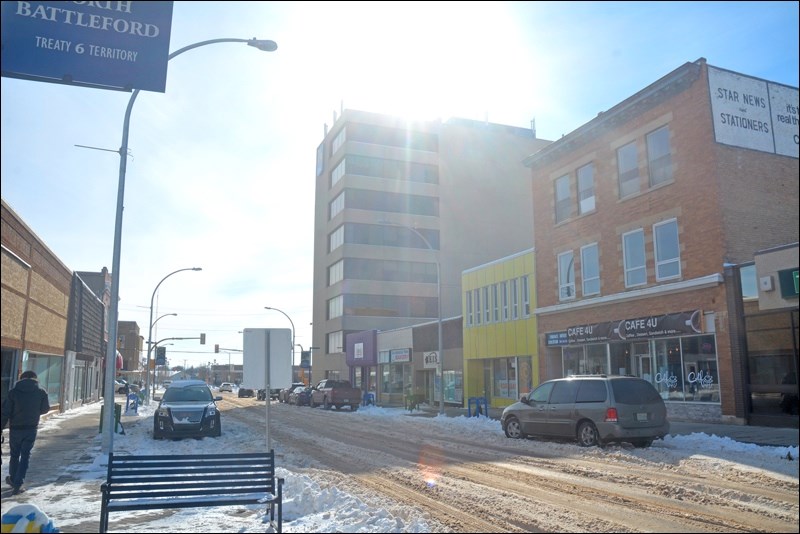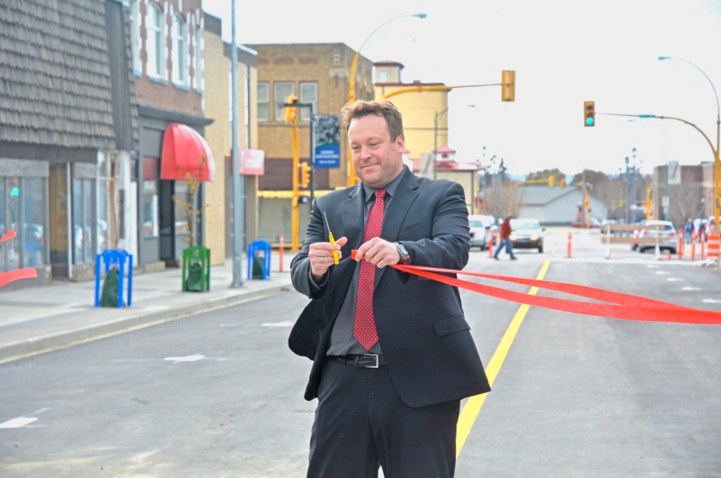Revitalizing downtown has been a long-term process going back a number of years.
The Downtown Revitalization Plan, explained in A walkable downtown: Part 1, was a work in progress for several years and there were a number of efforts under way prior to its formulation.
Among them were some tough zoning requirements to prevent new second-hand stores from opening in the downtown core. Those were brought in in response to the proliferation of pawnshops downtown.
Those rules ultimately have had the desired effect: slowly but surely, the number of pawn shops has dwindled. But other issues have remained.
For years, downtown was defined by crumbling buildings, empty storefronts and a lack of amenities such as restaurants. One attempt, the Longhorn Steakhouse, came and went. Vagrancy and even panhandling became noticeable along the street.
Shawn Gratton of Second Chance Goods said he’s seen public drunkenness, sex in public places, and public urination along 101st Street. Trevor Stone said he tries to help people off the streets before police find them.
In addition to the Downtown Revitalization Plan, the city has taken a number of measures to deter crime and encourage investment in the city’s downtown.
"We want to be a bad place to do bad business," City Manager Jim Puffalt said.
New Battlefords Chamber of Commerce president Terry Caldwell has committed to addressing the city’s reputation for crime during his tenure with the chamber. He has business interests downtown and is supportive of the revitalization efforts, but said crime could get in the way of that.
“To get investors and that, I think we really need to address the reputation problem. And to do that we need to address the crime problem,” Caldwell told the Regional Optimist recently.
“Once we are able to solve all those things we’ll get good investment down there. As you know, we have property down there. I would like to see it change for the positive in North Battleford also.”
Caldwell thinks the work that has been done to this point on 101st Street will make a big difference going forward.
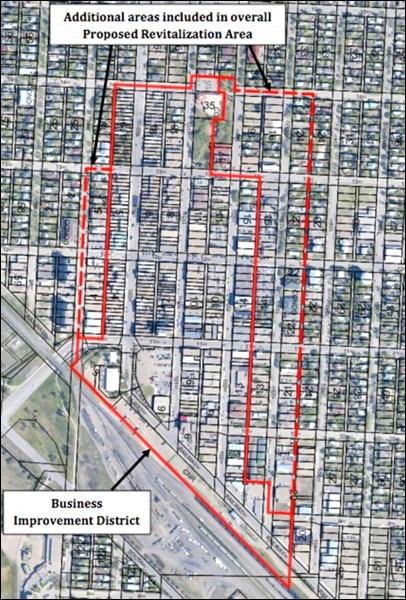
“[The street has] got the bones, it’s got the structure now for us to move forward. All the underground work has been done now, also all those things in the background are nicely done for us now.”
With respect to enhancing community safety, city officials have plans for more enforcement efforts downtown, with stepped-up downtown patrols so pedestrians will feel safer. The plan is for RCMP and Community Safety Officers to do those patrols. The community safety strategy is integrated into all of what will be happening.
“We do want to put a priority downtown,” said City Manager Jim Puffalt told the Regional Optimist in an interview at City Hall.
City officials also believe downtown will become a safer place simply by having more shoppers there.
Already, Mayor Ryan Bater said in the same interview, two new businesses have opened downtown and the new cinema is on the way, and that will mean more foot traffic, “which is why those patrols become more important.”
At a March 2018 council meeting, city council reached a new agreement with Magic Lantern Theatres to begin building a four-screen movie theatre.
“The more people come downtown, the less people feel comfortable about doing wrong acts,” said Puffalt, who noted Crime Prevention Though Environmental Design (CPTED) principles play a role here.
“Natural surveillance, eyes on the street, more lighting, all those things work to create the environment that doing bad things is not going to work. We want to be a bad place to do bad business.”
Puffalt also points to the importance of improving the look of downtown as fitting into part of their community safety strategy, in particular to improve peoples’ perceptions.
“Entrances and appearances of the community is really important, to again show that we care about our community, that we look after it and repair things that need to be repaired, and we do the right things, as well as replacing our infrastructure.”
Panhandling is also common downtown. In a News-Optimist poll, 33 per cent of responses stated that panhandling was the likeliest reason for not shopping downtown. Before the end of an interview, Trevor Stone asked for money to buy cigarettes.
Amendments were introduced in late September 2017 to change the city’s Panhandling and Public Behaviours Bylaw.
The amendments would increase the distance in front of certain locations where people are not allowed to panhandle from 10 metres, to 100 metres. Locations subject to the panhandling prohibition include banks, credit unions or trust companies, ATMs, bus stops, bus shelters, doorways to liquor stores or beer and wine stories, and pay telephones. Under the bylaw amendments, three more locations would be added to this list: pawn shops, quick cash locations and any business with a licence from the Saskatchewan Liquor and Gaming Authority.
At the time, Puffalt said the changes were proposed at the request of the RCMP who felt the existing bylaws didn’t allow them to carry out their duties. Some councillors at a September 2017 council meeting said they supported the amendments. Councillor Kent Lindgren disagreed.
“I don’t see a panhandling bylaw as a best response to the issues that we see in our community,” said Lindgren at the time. “There’s people in our community who have every right to be in our community. To me, this goes against really good governance of people in our community.”
The amendments were discussed again at the next council meeting, which included a delegation from local lawyer Ben Feist. Councillors Kevin Steinborn and Len Taylor pulled support for the amendments.
In the end the final vote was 5-2 against third reading of the panhandling bylaw amendments.
Mayor Ryan Bater was in favour of the amendments. Bater said he’d like to find a solution that involves engaging with the RCMP.
“I think it’s just a matter of finding the right policy that meets the needs of council,” Bater said at the time.
Phases
The city has interpreted the tasks outlined in the Downtown Revitalization Plan into phases.
Bater has often said to people at public functions that the city was not interested in commissioning studies that would then gather dust on a shelf.
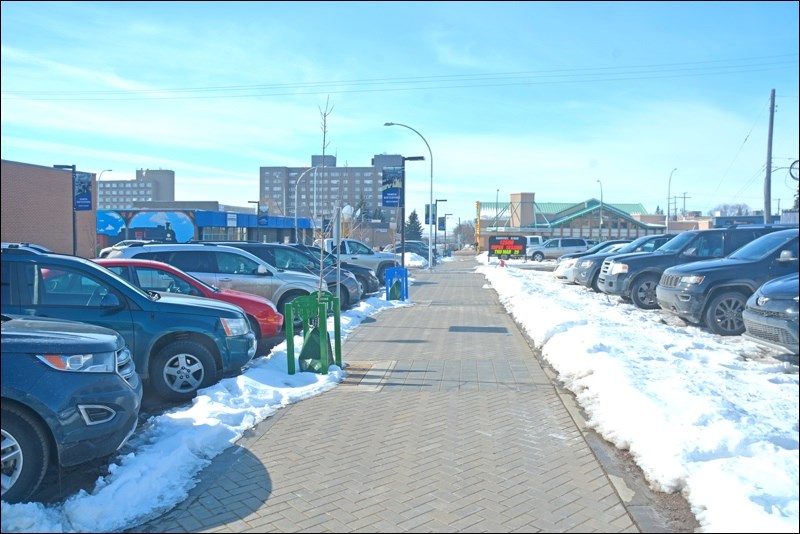
Work as part of Phase 1 took place from June to October 2017. Work on Phase 1 involved the Downtown “T”: 101st Street from 11th to 12th Avenue, and 12th Avenue from 100th to 102nd Street. The area is in the King Street Character Zone.
During 2017 budget deliberations, which took place in December 2016, director of planning and development Jennifer Niesink outlined plans to council to reconstruct roadways and sidewalks, and to incorporate streetscape amenities such as trees, waste containers, and benches.
“Along 101st Street there was some work but there were lead service lines replaced in the buildings. A lot of the buildings along that street are quite old, so the lead service lines were all replaced. The undergrounds were all inspected and replaced where need be.”
This meant tearing up the streets to get at all the underground work that needed to be done, so roadway reconstruction had to be included as well to handle the volume of traffic.
City Hall had already introduced an Underground Pipes and Roads levy (UPAR) to try and catch up to the infrastructure deficit facing the entire city; the Downtown “T” would be part of that.
During 2017 deliberations, Niesink had indicated there would be three different funding sources for Phase 1. One would be the $480,000 that was a holdover from 2016, the second would be another $520,000 for the rest of the work on 101st Street. That latter amount would be from debt financing. The third portion, the undergrounds work, was funded through the UPAR levy.
The reason why undergrounds was included in Phase 1, it was explained, was because of significant cost savings that could be achieved by doing all the work at once. At budget, the estimate presented was a saving of some 30 per cent.
In total, the final cost of the entire Phase 1 came to $1,696,000, which includes the underground work.
The finished street has a look and feel of being narrower than before, but that is actually not the case, Bater said.
“A lot of people thought that,” Bater said. “The sidewalks look fuller because there’s just so much on them now.”
The idea was to make 101st Street feel narrower, partly as a traffic-calming measure, said City Manager Jim Puffalt. That way, the area becomes pedestrian friendly.
“When you see something that looks unusual people start to slow down,” said Puffalt.
“It’s not that it’s unusual, it’s just there’s a whole bunch of stuff around there. You’re not driving down a highway, there’s things you’ve got to pay attention to.”
While council considered and ultimately approved the budget covering the projects on 101st Street, the deliberations actually took place before the Downtown Revitalization Plan was unveiled. There was some concern expressed about approving the budget before council members had a chance to see for themselves what the Plan had proposed, but the general feeling was that the project was needed and the money for it needed to be allocated, regardless of what details were in the Plan.
Construction toward the Downtown “T” began in late June. In late August, sidewalks opened, and Oct. 6 was announced as the project’s completion date. Phone calls to the News-Optimist, Facebook comments and other reports expressed discontent with the pace of construction work. The grand re-opening of 101 Street was Oct. 16.
In September, Bater said Saskatchewan has a very short construction season.
“Unfortunately, July and August is the time it has to happen.”
For 2018 budget deliberations, downtown redevelopment Phase 2 was proposed. The work planned is an extension of the Downtown “T” work the previous year, with work continuing along 101st Street beyond 12th Avenue into the City Hall area, extending up to Central Park, though not going into it this year.
Phase 2 won’t require as much underground work. Niesink said some lead service lines will be replaced, and reconstruction and patching of the road will be done as needed.
The 2018 budget has allocated $2.2 million to that project; however, a final figure is dependent on what comes back for tenders.
According to the city’s five-year capital plan, Phase 3 is slated for 2019 and 2020 at $1.5 million each year; Phase 4 is slated for 2021 at $1.5 million; and Phase 5 on Railway Avenue is slated for 2022 at a budgeted $1.6 million.
Where the work is done, and whether these projects go ahead, are dependent on budget in future years. Currently, the thinking is to begin Phase 3 work on 100th Street in 2019 from 11th to 14th Avenues.
“That block of 100th Street is in really bad shape underground,” Puffalt said. The concern from engineering is there could be possible breakage if they leave that work for very much longer.
Bater said there was consideration given to whether to go ahead with the 100th Street portion in 2018. Ultimately it was decided to push that portion back, because Magic Lantern was likely to start construction of its new cinema project along 11th Avenue this year.
“It would have been difficult to manage traffic patterns,” said Bater.
The other revitalization project planned for 2018 was a downtown pay parking lot on the King Street Station lot at the corner of Railway Avenue and 11th Avenue. The 2018 budget allocated $100,000 to turn the empty lot into paid parking during weekday hours.
While the lot is used right now by many local residents as parking, Bater said the lot is actually not a proper parking lot. As Bater points out it was an empty lot that was actually offered for sale.
In fact, for years the city had marketed a potential “King Street Station” development, full of restaurants, stores and offices, on that lot.
That effort didn’t fully realize its potential, with only the liquor store being developed there. However, hopes of developing the property revived when Magic Lantern offered to acquire it in 2016 with plans for a cinema complex there.
In addition to the actual road and sidewalk construction work, there have been other policies introduced at City Hall to encourage the development of properties in the downtown to get them back into circulation.
During council discussions setting the mill rate in 2017, administration proposed a special mill rate to be imposed on a new subclass of “vacant commercial properties” in the city, set at twice the commercial mill rate. The new mill rate targeted commercial buildings that did not have a utility connection or a business license since 2015.
City officials stated that the idea was to get vacant properties back into circulation again. Downtown was included, as was the key commercial corridor from 100th Street through Railway Avenue.
The other was the introduction of what was described as an aggressive downtown incentive program in 2017. Six new incentive programs were brought in, covering a range of activity from building improvements to new construction. Aggressive incentives waived not only the portion of the tax assessment related to improvements, but the entire assessment of the building when it came to the municipal portion of property taxes up to five years.
The first recipient of the tax incentive was Rainbow Cinemas, towards their major renovation project at the Capitol Theatre completed in 2017.
Other downtown efforts include $53,000 allocated towards parking enforcement equipment so that Community Safety Officers could issue parking tickets downtown. $35,000 was allocated for lighting in Central Park.
Public Art
The city recently approved the purchase of two pieces of public art by former North Battleford artist Patricia Shiplett. The two sculptures, “Ancient Voices,” and “Self Portrait,” are currently in Saskatoon. The two sculptures cost $3,000 each, plus costs associated with moving and installation. Shiplett passed away in May 2017.
“Self Portrait” is planned to be located at the entrance to Central Park near the intersection of 13th Avenue and 101st Street. “Ancient Voices” will not be part of the downtown landscape: it is planned to be located in the northwest corner of Peace Park near the intersection of 112th Street and 13th Avenue.
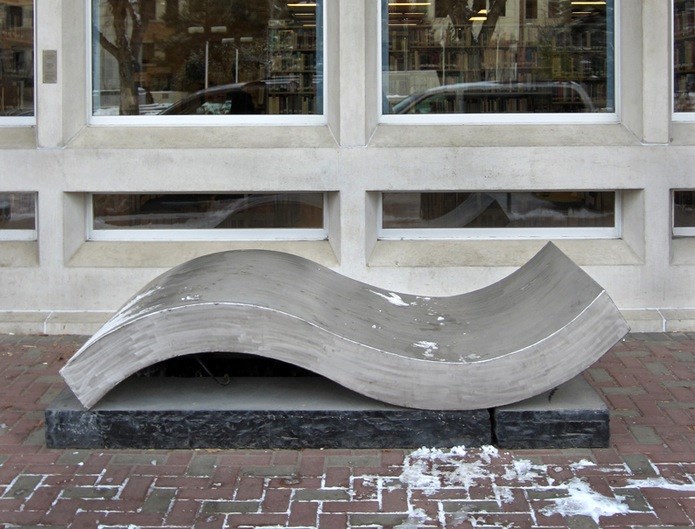
Walkable Winter?
There have been questions about the viability of a walkable downtown given the length of winter.
Minus-30 temperatures are an obvious disincentive to anyone coming downtown, although the leadership team at City Hall say the street should be well equipped to handle the elements.
“Our snow-removal strategy remains as it is, it’s a priority area,” said Bater.
Puffalt said that they have also made their city workers aware to watch for those areas on the street, such as the cobblestones, that might be trouble spots. Niesink said the cobblestones are sulfate resistant.
“We made people aware coming down with a grader to watch for these areas,” Puffalt said.
Gratton said he’s been told the new bricks are more slippery than previously, and “there’s been a few people who’ve almost wiped out.” Gratton said he salts the sidewalk in front of his property.
“I don’t know if that was something that was overlooked,” Gratton said.
Solar-powered lights on the newly installed bollards have also raised questions, as only a few actually lit up under 24-hour streetlights. According to Communications Coordinator Susanne Abe, the tops of the bollards along the street were removed in mid-February in order to be reprogrammed. The tops were reinstalled mid-March.
Summer
A Cadillac, which was stuck in front of BMO early in March, made it out of the snow after people pushed it out. Trevor Stone carried on down the street. People went about their business.
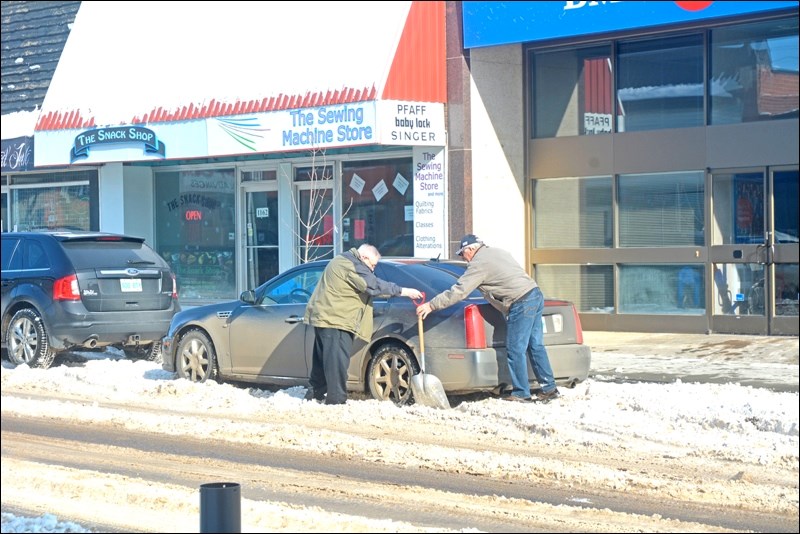
The weather got warmer over the week and the snow banks melted.
Shawn Gratton said he’s looking forward to summer, which he said should bring out more shoppers.
There are a number of things businesses can do, Gratton said, to encourage shopping downtown. He said he’d like to bring back Midnight Madness, in which shops would stay open late into the night with their merchandise on sale. He also said busking could improve the feel of the street, and businesses could participate in big flea markets, to be held periodically.
While he disagrees with decisions by city officials, Gratton said he gives the city credit for certain things, including the city buses and the car show, which he said brings foot traffic downtown.
Since Phase 1 concluded in October, Gratton said he hasn’t yet experienced what the new sidewalk can bring during summertime.
“We’ll see,” Gratton said. “Time will tell.”
